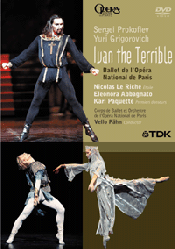Yet in 1973 the composer Mikhail Chulaki and the choreographer Yuri Grigorovich drew on Prokofiev’s film score to create his ballet entitled Ivan the Terrible, which was given its premiere in 1975. Revised as an instrumental work, Prokofiev’s music has new life in this highly evocative ballet, which includes arrangements of music from some of the composer’s other works. This production of Grigorovich’s ballet was filmed in December 2003 for television, and the video was prepared in conjunction with Radio France.
A two-act work in 18 scenes, the ballet begins with the coronation of Ivan IV, who faces conflicts with his boyars from the start. While his defeat of the Tatars encourages the population, the boyars only scheme to ascend the throne when Ivan falls ill. Upon recovering from an illness, Ivan retrenches his power as the first act ends. In the second act, Ivan’s wife Anastasia is the target of a plot by the boyars. They play upon Ivan’s emotions when Anastasia’s former love Count Kurbsky is the one who presents her with the cup that contains the poison. The plot succeeds, and Kurbsky flees to Poland for refuge. Ivan consolidates power and assumes the title of tsar to confirm his supreme authority as the imperial ruler of Russia.
The plot of the ballet is essentially that of Eisenstein’s film, and thus establishes a new context for Prokofiev’s music. By placing the music in this setting, Grigorovich did not change Prokofiev’s original intentions, since it is used essentially to illustrate the same story. In creating this pastiche Chulaki adapted the film score by removing the vocal portions and incorporating instrumental music from other works by Prokofiev. Nevertheless, this reworking is faithful to the composer’s original score by virtue of the music being used to convey the same story. It differs from some nineteenth-century pastiches in which the intended meaning of music for one work changes when reused for as part of another score. In fact, Grigorovich’s efforts show how Prokofiev’s highly evocative score lends itself well to dance. While the images that connect the music differ between the film and the ballet, the associations are effective. This is an excellent example of how well a work can be taken from one medium to another.
At the same time, this recording captures the essence of the ballet, with the music recorded well for this medium. Moreover, the production was intended as a television broadcast, and thus benefits from camera angles and other techniques that set it apart films of ballets in which the cameras are trained onto the stage without necessarily directing the viewers’ attention to certain angles and perspectives. Moreover, the details are critical to this film, since it is an attempt to bring life to a difficult period in Russian history, which is clearly more than a solely political effort on the part of Ivan. Rather, the combination of cultural elements, so vividly suggested by the costumes and movement, seems to underscore his ultimate motivation to seize power rather than abide with what was previously the nominal position as Russia’s ruler.
As to the music itself, the sound is as polished, and the orchestral colors that are critical to the film score are a wonderful foil for the choreography. The tolling of bells with which the ballet opens becomes a physical image as young men heave the tethers in conjunction with the sounds. Such literal images are as much part of the choreography as more delicate movement, as the intimate scenes between Ivan and Anastasia, which benefit from the carefully planned movement in Prokofiev’s Romeo and Juliet.
One of the more telling passages in the ballet is the depiction of Ivan’s efforts to control his country, as found in the “Oprichniks” scene in the second act. Beyond any prose description, the images in Grigorovich’s choreography depict Ivan’s mastering of his people through his secret police and ultimately, his control of the boyars. The ensemble works well in this intricately staged number that shows the cohesiveness of the company. At the same time, the film conveys the essence of the passage well, with wide images that capture the full stage, when necessary. Yet the camera also works in the opposite way to close in on the fitting expressions of Nicolas Le Riche, who truly acts the role of Ivan in this work. While the final section is entitled “The Triumph of the Russian People,” it is Ivan’s victory that is the focus of this ballet, and Nicolas Le Riche brings this off in his fine performance, down to the final, commanding gesture with which the works ends.
This is a fine DVD that makes this ballet available to a wider audience. Prokofiev’s music is fittingly used in this score, and the enthusiastic applause shows how it affected the audience. While it is not authentically a ballet that Prokofiev composed, it fits well with the composer’s other contributions to the genre. At the same time, this film demonstrates the quality of productions mounted by the Corps de Ballet of the Opéra National de Paris.
James L. Zychowicz
Madison, Wisconsin
